Israeli Scene
Feature
Dig In: Archaeology in Israel
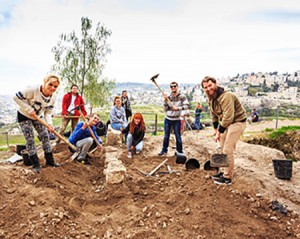
Archaeology is a hard, sweaty business. First you have to dig out and cart away buckets of soil that has accumulated for centuries, even millennia. Then you have to get down on your hands and knees and pick away at more dirt.
Yet, despite the arduous labor, thousands of volunteers take part each year in more than 200 excavations in Israel. Whether people volunteer for a single-day stint or for several weeks or more, it is a thrilling experience.
“It’s really fishing history out of the earth, and that’s what’s so exciting about it,” said Perla Amir, an Israeli retiree who volunteered with her husband at various sites between 2011 and 2015. “You’re touching things that people used 2,000 years ago. When you find a hairpin complete with decorations, you can imagine a woman putting it into her hair. When you find a beautifully crafted piece of glass, you can imagine how it looked on the table.”
The possibility of touching the past attracts volunteers of all ages—both Jews and non-Jews, from Israel and abroad—to excavation sites around the country. Many volunteers are students in search of university credit. Others are simply in search of adventure. Some are drawn by their love of the Bible and some enjoy the sociability of working in a group. And some—like Amir and her husband, David, both 65—are retirees in search of interesting ways to use their new abundance of time. The Israel Antiquities Authority alone placed 500 volunteers (100 from abroad) in dozens of sites in 2015, according to Meyrav Shay, the IAA’s public relations officer and coordinator of volunteers.
For the Amirs, who live in Kfar Saba, 15 miles northeast of Tel Aviv, archaeology is a natural extension of their love for the country and its history. “We love nature; we walk a lot,” Perla Amir said. “When you walk around and see heaps of stones, it means that something was there before.”
The Amirs’s first excavation was a one- day dig at Maresha, an ancient city adjacent to Beit Guvrin in the Judaean lowlands. Unfazed by the hard labor that Perla Amir described as “fun,” the couple subsequently worked at digs in Caesarea, Jaffa, Ness Ziona and Modi’in. Their efforts yielded some jewelry and ivory, but most of the time they found pottery and glass.
Some programs for young people from abroad, such as those of Young Judaea and the Jewish Agency for Israel’s Masa, include a dig. Most volunteers go through formal channels such as the IAA or university expeditions.
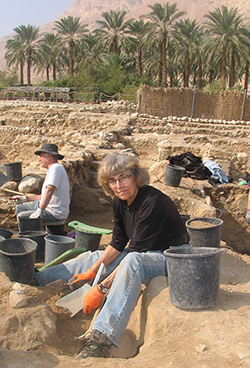
No prior experience is necessary, but “volunteers do not go straight to the field,” Shay said. “They get an explanation from the archaeologist on the process, the period and the specific site.” In part, the preparation is meant to create a commitment to the project so the volunteers won’t take home “souvenirs,” she explained. Since the enactment of Israel’s Antiquities Law of 1978, all finds are the property of the state.
Irene Shraga, 38, a medical office manager from East Brunswick, New Jersey, has participated in several one-day digs. Last year, she and her husband, Alex, 43, a physician, dug at the Beit Guvrin caves with their four children, then ranging in age from 1 to 11. “It was fun and physically challenging,” she said. “The kids loved it.”
Following an explanation about the history and time period of the site, she said, participants started digging, using a pick to loosen the soil. The soil goes into one bucket and the finds into another. The soil in the bucket is then sifted “to see if you missed anything,” Shraga said. At the end of the day, the volunteers gathered outside the caves under a shade tent to hear stories from the project and descriptions of the interesting finds.
The family’s finds at the dig, arranged through Archaeological Seminars Institute Dig for a Day, included many pottery shards, some animal bones, seashells (although the site is some distance from the sea) and pieces of jewelry.
Veteran volunteer Margaret Rowlands, 81, started digging 51 years ago, when the process and programs were less formal. Trained in England as an English teacher, she traveled the world with a friend; they ended up broke in Cyprus. There she learned that in Israel one could work in exchange for room and board. She was tired of teaching, so when she and her friend arrived in Israel and were asked what they knew how to do, they pretended to know something about archaeology.
Rowlands dug at Masada for two seasons before going back to England. She began returning to Israel to volunteer when she was between teaching jobs or had free time. Meanwhile, she earned a university degree in archaeology.
When she started volunteering regularly, the very first dig, at Gamla on the Golan Heights, was the site of her two most memorable finds. “I was clearing a wall and came to a shelf,” she recalled, where she found a solitaire-like game in the form of clay balls. Then the team “uncovered a room that turned out to be a bathroom,” with a shelf with little pots of makeup.
For the past 20 years, Rowlands has been coming every January to dig at the Ein Gedi Oasis Excavation, on the shores of the Dead Sea. One of the attractions is the temperature.
“For older people, it’s the right time of year; it gets us away from the cold and wet,” said Rowlands, who lives in Leyland, England. Also, she said, “it’s a beautiful place and a good group. We gel.”
According to archaeologist Gideon Hadas, 75, who has headed the Ein Gedi excavation since 2003, there are generally 20 volunteers at the site. For eight consecutive seasons, they dug in a village settled by Jews in the Second Temple period. In 2015, his team completed work on a sixth-century Byzantine-era house. The house is adjacent to a synagogue with a beautiful mosaic floor that existed between the fourth and sixth centuries.
The volunteers work from 7 A.M. to 2:30 P.M., stopping once for breakfast, which is served outdoors next to the excavation site. In the evening, they meet for lectures.
Rowlands can no longer dig because of a balance problem, so she is in charge of washing pottery shards and registering the day’s finds. And though she did not have to pay her own way when she first started, today, like all volunteers, she must pay for her own room and board as well as insurance.
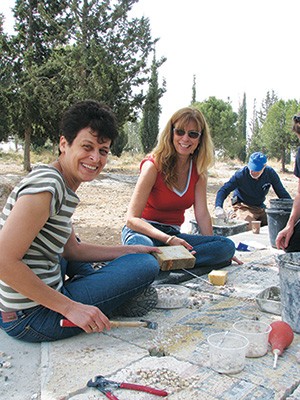
Shirley Korn, who is in her 80’s and lives in England, is still spry and able to wield a pick. She started volunteering in Ein Gedi in 2006, after hearing Hadas lecture at The British Museum in London and recalling a visit to Ein Gedi years before. For her, the main attraction is social. “I come mostly because the group is so cohesive,” she said. “There is such a good atmosphere and Gideon is very welcoming. It reminds me of the peaceful beauty of Israel” in its early days.
Korn’s most memorable find turned up while she was digging in parts of the village dating to the Second Temple period. In one room, she found a shelf holding a kohl stick, which was used as eye makeup at that time. Through that stick, she said, “I found my connection with women of that period.”
For Cesare Sacerdoti, who was born in Florence, Italy, and survived World War II hidden in a convent, digging at Ein Gedi was the fulfillment of a lifelong dream.
“I was always interested in archaeology, but I was just too busy,” said the former publisher of psychology books, now in his 70’s. Sixteen years ago, when he sold his business in London, where he now lives, he asked a friend at the IAA if they needed new volunteers. The answer was yes, and Sacerdoti headed to Ein Gedi to dig. He has come back every year since.
Sacerdoti recalled that, in the beginning, the work involved mainly heavy digging with hired Bedouin laborers. Now, in addition to less strenuous digging, he also does metal detecting, which is his special interest, using a detector that he donated to the Ein Gedi expedition.
Further north, an IAA group in Magdala, on the shores of the Kinneret, recently found several exciting objects, among them a decorated bronze incense shovel and a bronze jug with a handle in the shape of a woman’s leg. Discovered lying next to each other, the rare and finely preserved pieces are from a 2,000-year-old Jewish settlement. Incense shovels were used in the Temple for transferring embers from place to place and also in private homes.
Volunteers came from Chile, Mexico, Italy and Spain to participate in the Magdala dig. “They were absolutely thrilled” that these artifacts had been “waiting just below the surface,” said Eyad Bisharat, who supervised the section of the dig where the objects were found. The site, with religious and historical significance for both Jews and Christians, is considered a crossroads of the two religions. Among the finds there are Jewish ritual baths, a first-century synagogue and the Magdala Stone, which has the oldest carved image of the Second Temple’s seven-branched menora ever found.
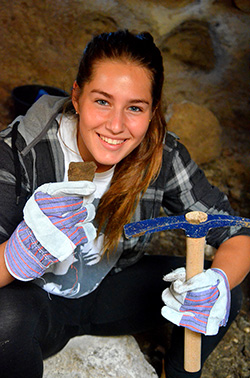
Israel has some 35,000 archaeological sites and hundreds of volunteer opportunities of varying lengths at 200 of them. University expeditions normally extend over several years, usually in the summers. Many of the IAA’s digs are salvage excavations—carried out before construction or other land development—that last only a few weeks and take place throughout the year. According to Shay, excavations are funded by private developers or the Department of Public Works, in the case of finds that are uncovered in the course of construction. The City of David excavations are funded by the El’ad Association, an organization that is controversial because of its political and settlement activities.
The IAA also has volunteer openings in Jerusalem in its mosaic workshop at the Rockefeller Archaeological Museum and in its coin and Dead Sea Scrolls departments at the Israel Museum, for those able to make a longer-term commitment. The mosaic workshop conserves mosaics that are brought there from throughout the country. Volunteers in marine archaeology must have certification in diving.
The magazine Biblical Archaeology Review lists information about digs each year in its January issue.
Participation in a dig costs from about $450 to $1,000 a week—volunteers pay for their own room, board and insurance—but this does not include airfare. For university digs, there may be additional fees, especially for those seeking college credit, about $100 to $340 per credit.
Volunteering in archaeology has an aura of romance about it, and archaeologist Pnina Shor, of the IAA, speaks fondly of the 1970s and early 1980s, when she was a field archaeologist in southern Israel. She recalled that at the peak of the large digs, there were more than 100 volunteers from all over the world. This was especially true at one of the main digs, in Kadesh Barnea, before the Sinai Peninsula was returned to Egypt in 1982 as part of the peace treaty between Israel and Egypt.
“What moved me most were the field conditions: setting up the tents, bathing in the spring that was terribly cold and, in the evenings, sitting around the campfire with the combination of young Israelis and people from abroad,” said Shor, who is in her 60’s. And, of course, “there were always romances,” she added, as there still are.
Shor recalled a volunteer who became a good friend—who had come on aliya—and whom she introduced to an archaeologist: “The two eventually married.”
But her most moving story is connected with the IAA pottery lab in Jerusalem, where vessels are reconstructed from shards. At the end of the 1990s, a representative of a facility for youngsters with autism asked whether a teenager who was a genius at assembling puzzles could volunteer in the lab. The facility’s staff hoped that this would help him become integrated in society, but the experience was a disaster at first. He was overwhelmed by the jumbled mass of pieces.
Shor soon realized that a special approach was needed, and one of the conservators had an idea. “She brought a flowerpot, smashed it and put the shards on the table. He put it together in a moment,” she said. “Then she broke two pots. And so he learned to separate the shards. He then worked for 10 years, coming once a week, until the conservator retired.”
Digging in the dirt may not be for everyone but, as Shor said, the country’s multitude of archaeological sites are a “national resource” and magnets that keep attracting adventurous souls.
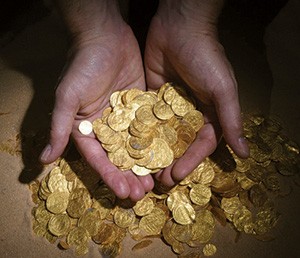
Hard, Shiny Evidence
Preparing coins for identification is a cleaner and less strenuous task than digging at excavation sites, but it requires a longer commitment. Coins are important as a supportive field of archaeology, said Donald Tzvi Ariel, head of the Israel Antiquities Authority’s coins department, located in the Israel Museum in Jerusalem. Providing dates of the coins helps archaeologists “date their strata,” the layers at which they are working.
In his department, a rotating group of volunteers do much of the technical work—weighing, measuring and recording relevant details—freeing the professional staff of three to identify the 8,000 coins they handle each year. This year’s volunteers live in Israel but were originally from Canada, the United States, England and Scotland.
Akiva Fialkoff, 30, sorted and logged thousands of coins during his eight-month volunteer stint in 2009. Fialkoff, who grew up in New York, arrived in Israel with a degree in archaeology. Now married and again living in the United States, he looks back fondly on his time working with Ariel. Fialkoff said he is intrigued by coins because, on the one hand, they “pinpoint when things happened,” but on the other hand, they don’t reveal why. “In the City of David, they found 400 gold coins,” Fialkoff said. “Someone left them there. Was there a fight? Something happened, [but] this piece of information is lost.”
Each coin arrives at the department with a tag indicating exactly where in the three-dimensional space of the archaeological site it was found. It is then catalogued in the IAA database and linked to the dig site. The coins’ circumference, weight and material are recorded, as is any writing or image on the coin. The subsequent analysis, by the professional staff, includes determining where the coins were minted. And that, Fialkoff said, provides “a macro picture of trade” at that time.
Gary Heller, 63, a retired New York educator, moved to Israel 20 years ago and works as a tour guide. He got hooked on archaeology by observing digs in Jerusalem’s Old City, and his interest became an important part of his work as a guide. “In order to understand Israel and its history and the development and how we got here,” he explained, “you need to have a good grasp of archaeology.”
For the past six years, he has worked one day a week at IAA, mostly with coins. Heller said he has come to realize that coins “are the best artifacts to study. It’s very concrete. You have a picture of an emperor, so you know what it is. With pottery—maybe it’s this, maybe it’s that; it’s more guesswork. Coins are hard evidence.”










 Facebook
Facebook Instagram
Instagram Twitter
Twitter
aimlee laderman says
good article. thank you